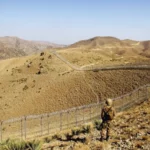In the tough and sometimes rocky region near the Pak-Afghan border, a tale of ongoing problems appeared. The historic Durand Line, marking a boundary between Pakistan and Afghanistan, has posed continuous challenges and tensions for both nations. This challenging backdrop set the stage for a diplomatic journey with agreements, tensions, and a commitment to working together. This shared frontier, spanning over 2,600 kilometers, has witnessed a complex interplay of historical disputes, security concerns, and the ebb and flow of refugees.
In recent times, the Pak-Afghan border region has been marred by a troubling tale of challenges, characterized by intermittent closures of key border crossings, diplomatic spats, and the expulsion of a significant number of undocumented foreigners, primarily Afghans.
Geopolitical Dynamics and Regional Rivalries
In the context of Pak-Afghan border tensions, the Durand Line, established in the colonial era, remains a contentious issue, perpetuating a longstanding historical dispute. The legacy of external interference during the Great Game continued to influence Afghanistan’s relations with neighboring countries and major powers into the 20th and 21st centuries. The geopolitical dynamics established during the Great Game have contributed to ongoing challenges in the region.
Afghanistan remains a focal point for global powers, facing the complexities of regional rivalries and influences. The Great Game established Afghanistan as a key player in the geopolitical struggles of the region. The country’s location between the British and Russian spheres of influence made it a critical piece on the chessboard of imperial ambitions. The demarcation of the Durand Line in 1893, a result of the Great Game, created a border separating Afghanistan from British India, now Pakistan. This artificial border later became a source of contention and contributed to regional tensions.
Historical Context of Pak-Afghan Border Tensions
The roots of the challenges along the Pak-Afghan border can be traced back to the colonial era when the Durand Line was established by the British in 1893. Despite being the de facto border, Afghanistan has never officially recognized the Durand Line, leading to a prolonged historical dispute. This disagreement has set the stage for a complex relationship, with both nations navigating a landscape fraught with territorial tensions and unresolved grievances.
![Amidst Pak-Afghan border crossing [Image via Al Jazeera].](https://southasiatimes.org/wp-content/uploads/2024/06/INTERACTIVE_AFGPKBORDER-CROSSINGS-01-1.webp)
In recent months, the Torkham border crossing, a crucial gateway between the two nations, has experienced frequent closures, amplifying the existing tensions. The situation reached a boiling point in September when clashes between border forces led to a nine-day closure, disrupting trade and straining diplomatic relations. The latest chapter in this turbulent saga unfolded with the Pakistan government’s decision to expel over a million undocumented foreigners, predominantly Afghans. This move has triggered a fresh wave of discord, with accusations and counter-claims further complicating an already delicate situation.
Impact of Pak-Afghan Border Disputes on Security
Territorial claims by both nations create complexity, impeding diplomatic resolutions and generating tension. Security challenges, marked by the militant presence and cross-border attacks, heighten concerns, straining relations between Pakistan and Afghanistan. The persistent inflow of refugees into Pakistan adds another layer of complexity, stretching resources and altering demographics in the border region. Economic disparities, trade conflicts, cultural distinctions, porous borders, and geopolitical dynamics further compound challenges, impacting bilateral relations.
The Torkham border crossing is the busiest trade route between Pakistan and Afghanistan. It remained shut for ten consecutive days amid strained relations between the two countries. The crossing was closed on January 13th after Pakistani officials at the crossing began asking for passports and visas from Afghan drivers under a new policy, prompting a reciprocal ban on Pakistani truckers by the Afghan Taliban authorities. The decision to close the border followed the Pakistani government’s choice to initiate the expulsion of over a million undocumented foreigners, predominantly Afghans, starting on November 1st. This action was taken amidst a dispute over allegations that Kabul shelters militants responsible for cross-border attacks.
Pakistan has asserted that the enforcement of legal travel document requirements is a global practice, and both Pakistan and Afghanistan are no exceptions to this standard.
The tough situation between Pakistan and Afghanistan has caused problems in their once-friendly relationship and trade. Even though Afghanistan is Pakistan’s top trading partner, with a strong trade of $135.30 million in August 2023, their economic connection has faced problems because of closed border points and strict efforts to send people back. The Torkham problem has caused big economic problems, losing about $100,000 every day for both countries. Even with a lot of talks, there’s no solution yet, and Torkham keeps closing and opening, like a tricky puzzle waiting to be solved.
![Truck drivers, laden with supplies bound for Afghanistan, pause as they queue at the Torkham border crossing in Pakistan, shut down by Taliban authorities. [Image via Reuters]](https://southasiatimes.org/wp-content/uploads/2024/06/2023-02-21T090231Z_1434613794_RC2KFZ9XHDUV_RTRMADP_3_AFGHANISTAN-CONFLICT-PAKISTAN.webp)
Historical Timeline of Pak-Afghan Border Conflicts
The timeline of border disputes between Pakistan and Afghanistan, coupled with the adverse effects on trade, is complex and multifaceted.
Following the partition of British India in 1947, the newly formed states of Pakistan and Afghanistan inherited the Durand Line as their shared border, sparking early tensions due to historical disputes over its legitimacy. In 1979, the Soviet invasion intensified conflict in the region, leading to an influx of Afghan refugees into Pakistan. The porous border exacerbated security concerns and strained resources on both sides. In 1989, the withdrawal of Soviet forces did not bring immediate stability. Instead, the power vacuum in Afghanistan contributed to the rise of militant groups, with cross-border attacks impacting the security situation along the border. In 2001, the U.S.-led War on Terror and the subsequent toppling of the Taliban regime led to increased instability in the border region. Militant groups found sanctuaries on both sides, leading to heightened security tensions.
In 2017, Pakistan initiated border management measures, including the construction of fencing and checkpoints, to curb illegal cross-border movements. This led to occasional clashes and closures, disrupting trade flows. Despite periodic closures, efforts were made to enhance trade relations. In 2019, the Torkham border crossing was reopened, aiming to facilitate legal trade and people-to-people contacts. In July 2020, a deadly clash occurred between Afghan and Pakistani forces at the Spin Boldak-Chaman border crossing, leading to casualties and a temporary closure. This incident heightened tensions and impacted trade. In 2021, ongoing disputes over border management and accusations of cross-border militancy continued to strain relations. Trade, particularly at border crossings like Torkham, faced disruptions due to intermittent closures and security concerns.
The consequences for trade have been notable across this timeline. Frequent border closures, clashes, and security concerns have disrupted the smooth flow of goods and people, impacting trade activities. The uncertainty and interruptions in trade have resulted in economic losses for businesses on both sides of the border, affecting livelihoods and economic stability in the region. The persistent border disputes and trade disruptions have contributed to a deterioration in diplomatic relations between Pakistan and Afghanistan, hindering efforts to foster cooperation and stability.
The chronology of border conflicts along the Pakistan-Afghanistan border has been marked by historical complexities and geopolitical shifts, with a pronounced impact on trade, economic stability, and diplomatic relations between the two nations. However, officials on both sides gauged the geo-strategic and political significance of the Pak-Afghan border. Therefore, on January 22, 2024, officials from Pakistan and Afghanistan convened at the border, reaching a consensus to roll out a revamped visa system for truck drivers, effective April 1. The mutual agreement entails the introduction of streamlined policies to facilitate a more accessible visa acquisition process for drivers, he further highlighted.
Humanitarian Concerns and Refugee Crisis
Amidst the political posturing and security considerations, a pressing humanitarian concern looms large. The forced eviction of a large number of Afghans, many of whom have lived in Pakistan for years, raises questions about the fate of these individuals upon their return to Afghanistan. The already fragile socio-economic conditions in Afghanistan, compounded by political instability, make the reintegration of returning refugees a formidable challenge. The international community has expressed concerns about the potential humanitarian crisis, urging both nations to prioritize the well-being of affected populations.
![Afghan refugees ascend a truck, getting set to depart for Afghanistan from a holding center in Landi Kotal. [Image via AFP]](https://southasiatimes.org/wp-content/uploads/2024/06/33ZL24U-highres-1698849032-1024x1024.webp)
As the troubling tale of challenges along the Pakistan-Afghanistan border unfolds, it becomes imperative for both nations to seek common ground and find sustainable solutions. A diplomatic resolution that addresses security concerns, respects the rights of displaced populations, and acknowledges historical grievances is essential for fostering lasting stability in the region. The international community’s role in supporting these efforts, through mediation and humanitarian assistance, cannot be overstated. The resilience of the people in the border regions, who have endured the brunt of these challenges, serves as a testament to the human spirit’s ability to endure and overcome adversity.
A Way Forward
The implementation of such proposed actions and approaches illustrated below will improve bilateral relations between Pakistan and Afghanistan thereby contributing to durable and cordial relations.
- Streamline visa processes for truck drivers at key border points like Torkham, Angor Ada, and Chaman, focusing on enhanced facilitation for smoother cross-border movements.
- To enhance bilateral trade, Pakistan should prioritize trade facilitation, invest in infrastructure, and diversify its export portfolio.
- Address the slow clearance process for trucks on both sides to overcome challenges in trade and ensure a more efficient flow of goods.
- Collaboratively implement measures to reduce the occurrence of frequent border closures, minimizing disruptions to bilateral trade activities.
- Establish an e-commerce framework for bilateral trade to facilitate transactions, address issues like non-payment, and provide a secure mechanism for money transfers.
- Engage the Pakistan-Afghanistan Joint Chamber of Commerce & Industry (PAJCCI) to resolve issues such as higher levies on specific goods reciprocated by both nations.
- Leverage the untapped potential of Afghan coal, explore opportunities for economic cooperation, and consider supporting Afghanistan in agriculture and livestock development.
The views expressed in this article are the author’s own. They do not necessarily reflect the editorial policy of the South Asia Times.
Maimona Saleem is a PhD scholar at the Department of Peace and Conflict Studies, National Defence University (NDU) Islamabad. Her research focuses on the intersection of peace, conflict, and security development in Pakistan, with a specific emphasis on the role of economic development in reducing conflict and promoting peace. Maimona's work explores the potential of peace-based approaches to unlock Pakistan's economic potential, drive growth, and enhance regional cooperation. She is committed to contributing to the development of innovative and inclusive solutions that address the complex challenges facing Pakistan and the region.

![Amidst Pak-Afghan border challenges, Pakistan and Afghanistan must seek common ground for sustainable solutions [Image via Getty].](https://southasiatimes.org/wp-content/uploads/2024/06/pakistan-afghanistan-border-trucks-GettyImages-1929199041.webp)



Add a Comment